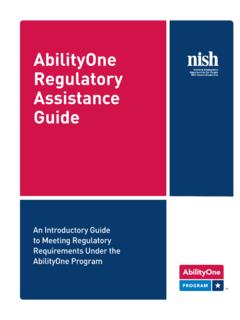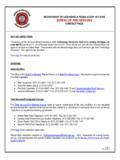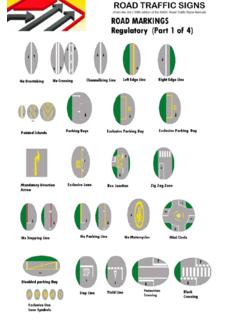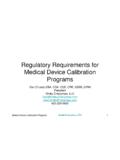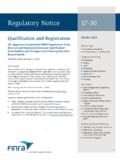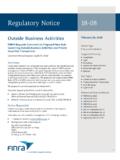Transcription of Applying IFRS IFRS 14 24Nov - EY
1 Applying ifrs . ifrs 14 regulatory Deferral Accounts Applying ifrs for ifrs 14 regulatory Deferral Accounts November 2014. Contents In this issue: 1. 3. Key features of ifrs 14 .. 3. Looking ahead .. 4. 2. Scope of the interim standard .. 4. Entities that conduct rate-regulated activities .. 4. 3. Recognition and measurement .. 6. Adoption of previous accounting policies applied prior to adoption of ifrs .. 6. Initial recognition and measurement .. 8. Accounting in subsequent periods .. 9. Service concession arrangements .. 10. Income taxes .. 10. 4. Impairment considerations .. 11. Determination of the recoverable amount of the CGU.
2 11. Allocation of the impairment losses within the CGU .. 11. 5. Group 12. Impact on associates, joint ventures and subsidiaries in the consolidated financial 12. Business combinations and acquisitions .. 12. 6. Presentation .. 13. Earnings per share .. 13. Non-current assets held for sale and discontinued operations .. 13. 7. Disclosures .. 14. 8. Effective dates and transition .. 15. November 2014 Applying ifrs for ifrs 14 regulatory Deferral Accounts 1. What you need to know ifrs 14 is an optional standard made available to first-time adopters of ifrs only. The standard is intended to provide some relief from derecognising rate-regulated assets and liabilities upon adoption of ifrs .
3 While the IASB continues to deliberate the comprehensive rate-regulated activities project. Existing ifrs preparers are prohibited from adopting this standard. The standard allows rate-regulated entities to continue recognising regulatory deferral accounts in accordance with their previous generally accepted accounting policies (GAAP), upon their first-time adoption of ifrs . Entities that adopt ifrs 14 must present the regulatory deferral accounts as separate line items on the statement of financial position and present movements in these account balances as separate line items in the statements of profit or loss and other comprehensive income.
4 The standard requires disclosure of the nature of, and risks associated with, the entity's rate regulation and the effects of the rate regulation on its financial statements. The standard is effective for annual periods beginning on or after 1 January 2016. Early application is permitted. The IASB is continuing its comprehensive rate-regulated activities project, which could result in either a standard on rate regulation or a decision not to develop specific requirements. By issuing ifrs 14, the IASB is not anticipating the outcome of the comprehensive project. 2 November 2014 Applying ifrs for ifrs 14 regulatory Deferral Accounts 1.
5 Introduction On 30 January 2014, the International Accounting Standards Board (IASB or the Board) issued ifrs 14 regulatory Deferral Accounts (the interim standard or ifrs 14) to ease the adoption of International Financial Reporting Standards ( ifrs ) for rate-regulated entities. The interim standard provides first-time adopters of ifrs with some relief from derecognising rate-regulated assets and liabilities until a comprehensive project on accounting for such assets and liabilities has been completed by the IASB. That said, there are differing views as to whether rate-regulated assets and liabilities meet the current definitions of assets and liabilities set out in the Conceptual Framework for Financial Reporting (conceptual framework) or the definitions included in the discussion paper on the IASB's project to revise the conceptual framework.
6 Therefore, it is important for rate-regulated entities to stay tuned to the IASB's progress on both the conceptual framework and comprehensive project. A discussion paper on the comprehensive rate-regulated activities project was issued on 17 September 2014, with the comment period ending on 15 January 2015; re-deliberations on the conceptual framework will continue during 2014. In this publication, we take a closer look at the requirements of ifrs 14, consider some of the potential benefits for reporting entities and explore some of the practical challenges in implementing it. We believe the insights and examples provided in this publication are particularly relevant for rate-regulated entities that are considering adopting ifrs for the first time.
7 Key features of ifrs 14. Below are some of the key features of this interim standard: ifrs 14 is intended a) It allows (but does not require) an entity whose activities are subject to rate to encourage regulation to continue Applying most of its existing accounting policies for rate-regulated entities regulatory deferral account balances upon first-time adoption of ifrs . to adopt ifrs while the b) Existing ifrs preparers are prohibited from Applying this standard. Also, IASB continues its work an entity whose current GAAP does not allow the recognition of on the comprehensive rate-regulated assets and liabilities, or that has not adopted such policy rate-regulated activities under its current GAAP, would not be allowed to recognise them on project.
8 First-time application of ifrs . c) Entities that adopt this standard must present the regulatory deferral accounts as separate line items in the statement of financial position and present movements in these account balances as separate line items in the statement of profit or loss and other comprehensive income (OCI). d) The standard requires disclosures on the nature of, and risks associated with, the entity's rate regulation and the effects of that rate regulation on its financial statements. e) If the standard is applied, full retrospective application is required. ifrs 14 is an optional standard that is intended to encourage rate-regulated entities to adopt ifrs while bridging the gap with similar entities that already apply ifrs , but which do not recognise regulatory deferral accounts.
9 This would be achieved by requiring separate presentation of the regulatory deferral account balances (and movements in these balances) in the statement of financial position and statements of profit or loss and other comprehensive income. November 2014 Applying ifrs for ifrs 14 regulatory Deferral Accounts 3. Looking ahead At the time of issuing ifrs 14, the IASB made it clear that the interim standard is not intended to anticipate the outcome of the comprehensive project. This means that the comprehensive project could result in either a standard on rate regulation or a decision not to develop specific requirements. Therefore, entities that elect to adopt ifrs 14 should be aware that the regulatory deferral account balances may need to be derecognised from their financial statements if the IASB decides not to issue a separate standard upon completion of the comprehensive rate-regulated activities project, or to issue a standard prohibiting recognition of (certain elements of) deferral account balances.
10 2. Scope of the interim standard Only first-time adopters can avail themselves of ifrs 14. ifrs 14 must not be adopted by entities that are currently preparing their financial statements under ifrs . Therefore, ifrs 14 is applied exclusively in connection with ifrs 1 First-time Adoption of International Financial Reporting Standards. An entity whose current GAAP does not allow the recognition of rate-regulated assets and liabilities, or that has not adopted such policy under its current GAAP, would not be allowed to recognise them through the adoption of ifrs 14. If an entity commences rate-regulated activities after adopting ifrs , the entity would be considered an existing ifrs preparer and, as such, would be prohibited from Applying ifrs 14.










